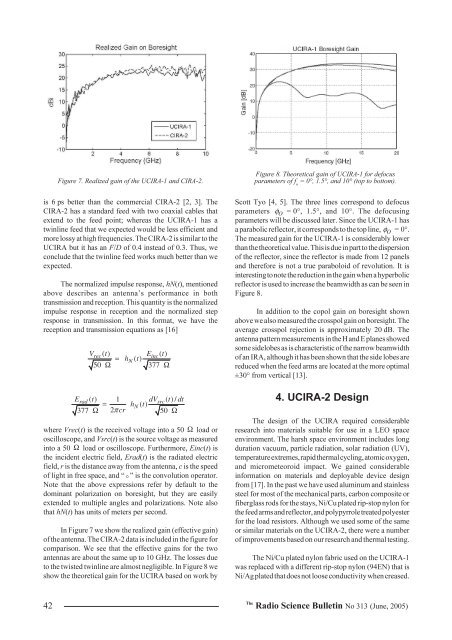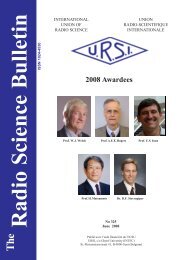Radio Science Bulletin 313 - June 2005 - URSI
Radio Science Bulletin 313 - June 2005 - URSI
Radio Science Bulletin 313 - June 2005 - URSI
- No tags were found...
Create successful ePaper yourself
Turn your PDF publications into a flip-book with our unique Google optimized e-Paper software.
Figure 7. Realized gain of the UCIRA-1 and CIRA-2.is 6 ps better than the commercial CIRA-2 [2, 3]. TheCIRA-2 has a standard feed with two coaxial cables thatextend to the feed point; whereas the UCIRA-1 has atwinline feed that we expected would be less efficient andmore lossy at high frequencies. The CIRA-2 is similar to theUCIRA but it has an F/D of 0.4 instead of 0.3. Thus, weconclude that the twinline feed works much better than weexpected.The normalized impulse response, hN(t), mentionedabove describes an antenna’s performance in bothtransmission and reception. This quantity is the normalizedimpulse response in reception and the normalized stepresponse in transmission. In this format, we have thereception and transmission equations as [16]V rec() t inc()= hN() tE t50 Ω 377 ΩE rad () t 1()/= h ()srcN tdV t dt377 Ω 2π cr 50 Ωwhere Vrec(t) is the received voltage into a 50 Ω load oroscilloscope, and Vsrc(t) is the source voltage as measuredinto a 50 Ω load or oscilloscope. Furthermore, Einc(t) isthe incident electric field, Erad(t) is the radiated electricfield, r is the distance away from the antenna, c is the speedof light in free space, and “ D ” is the convolution operator.Note that the above expressions refer by default to thedominant polarization on boresight, but they are easilyextended to multiple angles and polarizations. Note alsothat hN(t) has units of meters per second.In Figure 7 we show the realized gain (effective gain)of the antenna. The CIRA-2 data is included in the figure forcomparison. We see that the effective gains for the twoantennas are about the same up to 10 GHz. The losses dueto the twisted twinline are almost negligible. In Figure 8 weshow the theoretical gain for the UCIRA based on work byFigure 8. Theoretical gain of UCIRA-1 for defocusparameters of f o= 0°, 1.5°, and 10° (top to bottom).Scott Tyo [4, 5]. The three lines correspond to defocusparameters φ O = 0°, 1.5°, and 10°. The defocusingparameters will be discussed later. Since the UCIRA-1 hasa parabolic reflector, it corresponds to the top line, φ O = 0°.The measured gain for the UCIRA-1 is considerably lowerthan the theoretical value. This is due in part to the dispersionof the reflector, since the reflector is made from 12 panelsand therefore is not a true paraboloid of revolution. It isinteresting to note the reduction in the gain when a hyperbolicreflector is used to increase the beamwidth as can be seen inFigure 8.In addition to the copol gain on boresight shownabove we also measured the crosspol gain on boresight. Theaverage crosspol rejection is approximately 20 dB. Theantenna pattern measurements in the H and E planes showedsome sidelobes as is characteristic of the narrow beamwidthof an IRA, although it has been shown that the side lobes arereduced when the feed arms are located at the more optimal±30° from vertical [13].4. UCIRA-2 DesignThe design of the UCIRA required considerableresearch into materials suitable for use in a LEO spaceenvironment. The harsh space environment includes longduration vacuum, particle radiation, solar radiation (UV),temperature extremes, rapid thermal cycling, atomic oxygen,and micrometeoroid impact. We gained considerableinformation on materials and deployable device designfrom [17]. In the past we have used aluminum and stainlesssteel for most of the mechanical parts, carbon composite orfiberglass rods for the stays, Ni/Cu plated rip-stop nylon forthe feed arms and reflector, and polypyrrole treated polyesterfor the load resistors. Although we used some of the sameor similar materials on the UCIRA-2, there were a numberof improvements based on our research and thermal testing.The Ni/Cu plated nylon fabric used on the UCIRA-1was replaced with a different rip-stop nylon (94EN) that isNi/Ag plated that does not loose conductivity when creased.42The<strong>Radio</strong> <strong>Science</strong> <strong>Bulletin</strong> No <strong>313</strong> (<strong>June</strong>, <strong>2005</strong>)
















